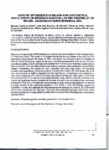Please use this identifier to cite or link to this item:
http://www.alice.cnptia.embrapa.br/alice/handle/doc/1027045Full metadata record
| DC Field | Value | Language |
|---|---|---|
| dc.contributor.author | SOUZA, F. S. de | pt_BR |
| dc.contributor.author | OLIVEIRA, E. J. F. de | pt_BR |
| dc.contributor.author | RIBEIRO, M. de F. | pt_BR |
| dc.contributor.author | SOUZA, B. de A. | pt_BR |
| dc.contributor.author | COSTA, M. A. P. de C. | pt_BR |
| dc.contributor.author | CARVALHO, C. A. L. de | pt_BR |
| dc.date.accessioned | 2015-10-22T11:11:11Z | pt_BR |
| dc.date.available | 2015-10-22T11:11:11Z | pt_BR |
| dc.date.created | 2015-10-22 | pt_BR |
| dc.date.issued | 2015 | pt_BR |
| dc.identifier.citation | In: ENCONTRO SOBRE ABELHAS, 11., 2015, Ribeirão Preto. Anais... Ribeirão Preto: USP: FCLRP, 2015. | pt_BR |
| dc.identifier.uri | http://www.alice.cnptia.embrapa.br/alice/handle/doc/1027045 | pt_BR |
| dc.description | Melipona subnitida Ducke (1910) (Jandaíra) is a stingless bee species endemic to the Caatinga biome, in northeastem Brazil. This species is well adapted to the hot and dry climate of the region and has traditionally been exploited for honey. In 1983, such species was introduced into the Femando de Noronha Island (Pemambuco state). In this study, data from mitochondrial DNA for the Cal gene (cytochrome oxidas e I) of M subnitida were obtained from 13 Femando de Noronha (island) colonies and compared to 160 continental colonies from different locations ofthe northeastem Brazil (Bahia, Alagoas, Pemambuco, Rio Grande do Norte, Maranhão, Piauí and Ceará states). The haplotype diversity (Hd) ranged from 0.000 in Femando de Noronha (PE), Cumaru (PE) and Passira (PE) (with only one haplotype) to 0.806 in Parnaíba (PI) (four haplotypes). 14 haplotypes were identified, of these eleven haplotypes (H 1 to H 11) have been deposited in GenBank by other authors, while three new haplotypes (H12, H13 and H14) were identified in this study, with H12 being the commonest. H4 was the only haplotype found in Femando de Noronha, although it was also found in four continental populations. There was a low haplotype and nucleotide diversity in the island populations as opposed to a high diversity in the continental populations (Hd= 0.824; n=160). Our findings suggest two hypotheses: (1) only one haplotype has been introduced into Femando de Noronha; or (2) the island environment selected only one haplotype. The results showed that the haplotypes entering the island, remaining isolated for 31 years, probably suffered the bottleneck effect with fixing only one haplotype (founder effect). | eng |
| dc.language.iso | eng | eng |
| dc.rights | openAccess | eng |
| dc.subject | Meliponini | pt_BR |
| dc.subject | Abelha Jandaira | pt_BR |
| dc.subject | Variabilidade genética | pt_BR |
| dc.subject | Genetic variability | pt_BR |
| dc.subject | Insect | pt_BR |
| dc.subject | Bioma Caatinga | eng |
| dc.subject | Abelha sem ferrão | eng |
| dc.title | Genetic divergence in island and continental populations of Melipona subnitida, in the Northeast of Brazil: analysis of mitochondrial DNA. | pt_BR |
| dc.type | Resumo em anais e proceedings | pt_BR |
| dc.date.updated | 2016-02-23T11:11:11Z | pt_BR |
| dc.subject.thesagro | Abelha | pt_BR |
| dc.subject.thesagro | Inseto | pt_BR |
| dc.subject.thesagro | DNA | pt_BR |
| dc.subject.thesagro | Caatinga | eng |
| dc.subject.nalthesaurus | Pollination | eng |
| dc.format.extent2 | p. 301. | pt_BR |
| riaa.ainfo.id | 1027045 | pt_BR |
| riaa.ainfo.lastupdate | 2016-02-23 | pt_BR |
| dc.contributor.institution | FLAVIANE SANTOS DE SOUZA, Universidade Federal do Recôncavo da Bahia | pt_BR |
| dc.contributor.institution | EDDY JOSÉ FRANCISCO DE OLIVEIRA, Universidade Estadual de Feira de Santana | eng |
| dc.contributor.institution | MARCIA DE FATIMA RIBEIRO, CPATSA | eng |
| dc.contributor.institution | BRUNO DE ALMEIDA SOUZA, CPAMN | eng |
| dc.contributor.institution | MARIA ANGÉLICA PEREIRA DE CARVALHO COSTA, Universidade Federal do Recôncavo da Bahia | eng |
| dc.contributor.institution | CARLOS ALFREDO LOPES DE CARVALHO, Universidade Federal do Recôncavo da Bahia. | eng |
| Appears in Collections: | Resumo em anais de congresso (CPATSA)  | |
Files in This Item:
| File | Description | Size | Format | |
|---|---|---|---|---|
| Marcia3.pdf | 768,77 kB | Adobe PDF |  View/Open |









